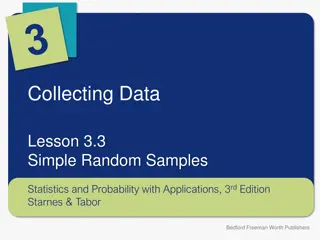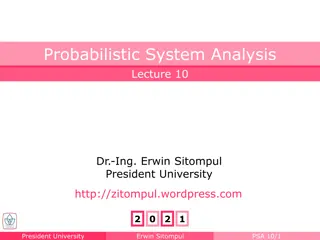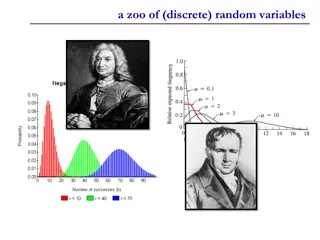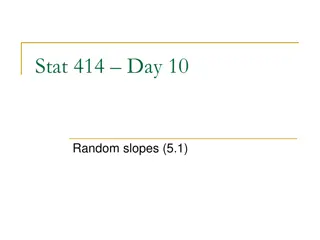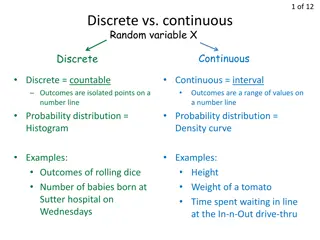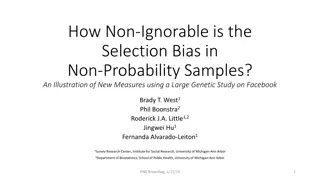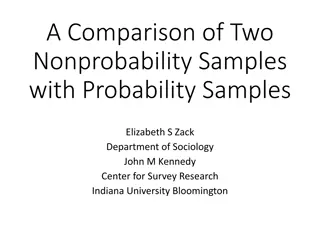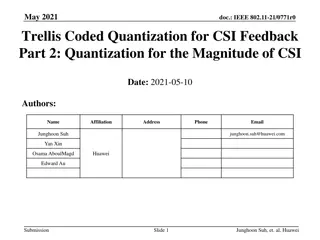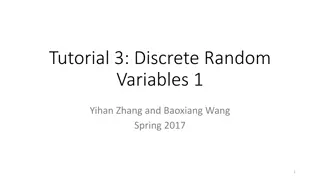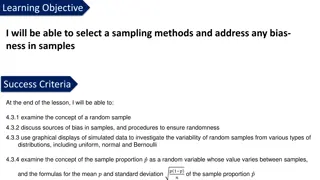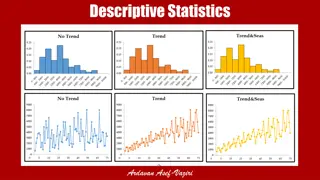Proposal for Random Access Efficiency Enhancement in IEEE 802.11be Networks
This document presents a proposal for enhancing random access efficiency in IEEE 802.11be networks through a Random-Access NFRP (RA-NFRP) principle. The proposal addresses the challenges of low efficiency in the current UORA procedure and introduces modifications based on the 802.11ax standard to im
7 views • 16 slides
Bluetooth Low Energy Addresses in IEEE 802.11-21/1535r0
The document explores the features of resolvable addresses in Bluetooth Low Energy (BLE) within the IEEE 802.11-21/1535r0 standard. It discusses the two types of addresses in BLE, Public and Random, and their usage. The emphasis is on Random addresses due to their popularity and privacy features. Th
2 views • 11 slides
Systematic Analysis of Real Samples in Analytical Chemistry
This analysis covers the systematic process involved in analyzing real samples, including sampling, sample preservation, and sample preparation. It discusses the importance of accurate sampling in obtaining information about various substances, such as solids, liquids, gases, and biological material
0 views • 54 slides
Random Forests: A Comprehensive Overview
Random Forests, a popular ensemble learning technique, utilize the wisdom of the crowd and diversification to improve prediction accuracy. This method involves building multiple decision trees in randomly selected subspaces of the feature space. By combining the predictions of these trees through a
1 views • 21 slides
Simplifying Random Assignment with The Cambridge Randomizer
The Cambridge Randomizer offers a cost-effective and efficient solution for random assignment in research studies, enabling treatment providers to conduct the process securely. This innovative online portal streamlines the assessment of participant eligibility, provides instant baseline data, and en
2 views • 8 slides
High-Throughput True Random Number Generation Using QUAC-TRNG
DRAM-based QUAC-TRNG provides high-throughput and low-latency true random number generation by utilizing commodity DRAM devices. By employing Quadruple Row Activation (QUAC), this method outperforms existing TRNGs, achieving a 15.08x improvement in throughput and passing all 15 NIST randomness tests
1 views • 10 slides
Simple Random Samples in Statistics
In this lesson, you will learn how to obtain a simple random sample using slips of paper or technology, understand sampling variability and the impact of sample size, and use simulations to test claims about population proportions. The concept of Simple Random Sample (SRS) is explained, where every
0 views • 18 slides
Random Variables and Their Applications in Various Fields
Random variables play a crucial role in statistics, engineering, and business applications. They can be discrete or continuous, depending on the nature of the outcomes. Discrete random variables have countable values, while continuous random variables can take on any real number. This article explor
1 views • 6 slides
Random Variables and Probability Distributions
Random variables are variables whose values are unknown and can be discrete or continuous. Probability distributions provide the likelihood of outcomes in a random experiment. Learn how random variables are used in quantifying outcomes and differentiating from algebraic variables. Explore types of r
2 views • 13 slides
Advanced Imputation Methods for Missing Prices in PPI Survey
Explore the innovative techniques for handling missing prices in the Producer Price Index (PPI) survey conducted by the U.S. Bureau of Labor Statistics. The article delves into different imputation methods such as Cell Mean Imputation, Random Forest, Amelia, MICE Predictive Mean Matching, MI Predict
0 views • 22 slides
Random Class in Java Programming
The Random class in Java is used to generate pseudo-random numbers. By utilizing methods such as nextInt and nextDouble, you can generate random integers and real numbers within specified ranges. This chapter explores common usage scenarios, such as generating random numbers between specific ranges
2 views • 10 slides
Random Sampling in Probabilistic System Analysis
In the field of statistical inference, random sampling plays a crucial role in drawing conclusions about populations based on representative samples. This lecture by Dr. Erwin Sitompul at President University delves into the concepts of sampling distributions, unbiased sampling procedures, and impor
1 views • 23 slides
Quantum Key Agreements and Random Oracles
This academic paper explores the impossibility of achieving key agreements using quantum random oracles, discussing the challenges and limitations in quantum communication, cryptographic protocols, quantum computation, and classical communication. The study delves into the implications of quantum ra
1 views • 29 slides
Approximate Inference in Bayes Nets: Random vs. Rejection Sampling
Approximate inference methods in Bayes nets, such as random and rejection sampling, utilize Monte Carlo algorithms for stochastic sampling to estimate complex probabilities. Random sampling involves sampling in topological order, while rejection sampling generates samples from hard-to-sample distrib
0 views • 9 slides
Comparison of Random-Digit Dial vs. Web Panel Employment Survey Samples
This study compares samples from random-digit dialing (RDD) and web-based panel surveys in employment data collection. Findings highlight differences in demographics, age distribution, race composition, and regional representation between the two survey methods. The goal is to assess survey accuracy
1 views • 23 slides
Random Numbers in Computers
Explore the concept of true random numbers versus pseudorandom numbers in computers. Learn how pseudorandom numbers are generated algorithmically but predictable, while true random numbers are derived from physical phenomena like radioactive decay. Discover the relevance of high-entropy pseudorandom
0 views • 57 slides
IEEE 802.11-21/1585r10: Identifiable Random MAC Address Presentation Summary
This presentation discusses the concept of Identifiable Random MAC (IRM) addresses in the IEEE 802.11-21/1585r10 standard. It covers the purpose of IRM addresses in preventing third-party tracking while allowing trusted parties to identify specific devices. The presentation outlines the use of Ident
1 views • 24 slides
Laplace Transforms for Continuous Random Variables
The Laplace transform is introduced as a generating function for common continuous random variables, complementing the z-transform for discrete ones. By using the Laplace transform, complex evaluations become simplified, making it easy to analyze different types of transforms. The transform of a con
0 views • 17 slides
Discrete Random Variables and Variance Relationships
Explore the concepts of independence in random variables, shifting variances, and facts about variance in the context of discrete random variables. Learn about key relationships such as Var(X + Y) = Var(X) + Var(Y) and discover common patterns in the Discrete Random Variable Zoo. Embrace the goal of
1 views • 27 slides
Analytical Toxicology: Techniques and Sample Analysis in Clinical Toxicology
Analytical toxicology involves the observation, identification, and measurement of foreign compounds in biological and other samples, such as urine, blood, stomach contents, nails, hair, and DNA. Various techniques are used to isolate and identify drugs and poisons present in these samples. This fie
3 views • 12 slides
GUC-Secure Commitments via Random Oracles: New Findings
Exploring the feasibility of GUC-secure commitments using global random oracles, this research delves into the differences between local and global random oracles, outlining motivations and future work. It discusses UC frameworks, zero-knowledge proofs, oblivious transfers, and the GUC framework for
1 views • 18 slides
A Zoo of Discrete Random Variables
Discrete random variables play a crucial role in probability theory and statistics. This content explores three key types: Bernoulli random variable, binomial random variable, and error-correcting codes. From understanding the basics of Bernoulli trials to exploring the application of error correcti
0 views • 27 slides
Random Slopes in Data Analysis
Exploring the impact of grand-mean and group-mean centering on intercept interpretation with random slopes, as well as variations in slope/intercept covariance. Differentiating between fixed and random coefficients, and the effects of adding group mean as a Level 2 variable. Delving into within vs.
1 views • 21 slides
Random Variables and Mean in Statistics
Random variables can be discrete or continuous, with outcomes represented as isolated points or intervals. The Law of Large Numbers shows how the mean of observed values approaches the population mean as the number of trials increases. Calculating the mean of a random variable involves finding the e
0 views • 13 slides
How Non-Ignorable is the Selection Bias in Non-Probability Samples?
Big Data often derive from non-probability samples, necessitating model-based approaches for inference. Tools to gauge non-ignorable selection bias in descriptive estimates from such samples are lacking. This work aims to address this gap by developing new measures. Building on previous work, the st
0 views • 27 slides
Comparison of Nonprobability Samples in Social Science Research
This study examines the use of nonprobability online panels in social science research, comparing them with probability samples. It explores the conditions under which nonprobability samples can be employed, the comparability of multivariate models generated from online panels with gold standard sur
0 views • 37 slides
Comparison of Random-Digit Dialing vs. Web Panel in Employment Survey Samples
This study compares the effectiveness of random-digit dialing (RDD) and web panels in obtaining employment survey data, highlighting differences in demographics, age distribution, race, and region. Findings reveal disparities between RDD and web samples, offering insights for survey methodology sele
0 views • 23 slides
Randomized Algorithms and Independence Concepts
Types of independence in randomized algorithms are explored alongside the concept of random bit complexity and generation. The idea of mutually independent random variables versus pairwise independent random variables is discussed, illustrating how to generate uniformly random and pairwise independe
1 views • 18 slides
Random Number and Variate Generation Overview
Random numbers play a crucial role in modern computing, aiding in cryptography, simulation, and system testing. This overview delves into the properties of random numbers, the generation of pseudo-random numbers, techniques for generating them, and tests for their validity. It explores the significa
0 views • 59 slides
Trend for Precision Soil Testing Zones
Explore the evolution of precision soil testing practices over the years, focusing on zone or grid samples tested compared to total samples. Dive into the data on zone or grid samples tested compared to conventional whole field composite samples in 2017. Delve into the insights provided by AGVISE La
0 views • 34 slides
Trellis Coded Quantization for CSI Feedback Part 2: Magnitude Quantization
In this document, the authors delve into applying Trellis Coded Quantization (TCQ) to the magnitude of Channel State Information (CSI) feedback. They discuss converting Rayleigh-distributed samples to uniformly distributed samples for quantizing the CSI magnitude. The content covers statistics of Ra
0 views • 17 slides
Fundamental Sampling Distributions and Random Sampling in Statistical Analysis
In statistical analysis, understanding fundamental sampling distributions and random sampling is crucial for making accurate inferences about populations. Sampling involves selecting a subset from a population to draw conclusions when observing the entire population is impractical. Random sampling h
0 views • 23 slides
Identification of Fire-Retardant Chemical Treatments in Fiber Samples
Dive into the world of forensic fiber analysis with a focus on identifying fire-retardant chemical residues in fiber samples using instrumental analysis techniques. Follow Caitlin Dillon's research journey at Embry-Riddle Aeronautical University as she develops a method to differentiate fibers based
0 views • 9 slides
Discrete Random Variables and Associated Probability Functions
Explore the concept of discrete random variables, their associated probability mass functions, and examples of typical discrete random variables like the Binomial and Poisson random variables. Understand the difference between discrete and continuous random variables with practical examples.
0 views • 19 slides
Sampling Techniques in Statistics
Understand the importance of unbiased samples in statistical studies by exploring various sampling techniques such as voluntary response samples, convenience samples, and simple random samples. Learn how biased samples can impact study outcomes and the significance of representative samples. Practic
0 views • 21 slides
Microscopy Analyses of Fusion Devices Samples in 2021
Explore the microscopy studies and characterization of samples from fusion devices like AUG, WEST, and W7-X in 2021. Learn about the ongoing work, sample details, techniques used, and new samples for analysis, including surface modifications and co-deposits. Kick-off meeting details and tasks for pl
0 views • 7 slides
Methods for Sampling to Address Bias in Statistical Analysis
Learn about different sampling methods to ensure randomness and address bias in statistical analysis, including random samples, sources of bias, and procedures for creating unbiased samples from various distributions like uniform and normal. Understand primary and secondary data, population vs. samp
0 views • 30 slides
Understanding Descriptive Statistics and Random Variables
Explore the concepts of descriptive statistics, random variables, measures of centralization and dispersion, and more with Ardavan Asef-Vaziri. Learn about numerical and categorical random variables, modes, variances, standard deviations, and coefficients of variation. Gain insights on variability i
0 views • 9 slides
Understanding Sampling Methods for Population Studies
Learn about the challenges of studying entire populations and how sampling methods such as random and non-random sampling help generalize findings effectively. Explore probability and non-probability sampling techniques, including simple random sampling and systematic random sampling.
0 views • 13 slides
Random Number and Variate Generation Overview
Discover the importance of random number generation, including pseudo-random numbers and their applications in computing, cryptography, and simulation. Explore historical methods and properties of random numbers for effective simulation and system testing. Learn about the uniformity and independence
0 views • 59 slides






